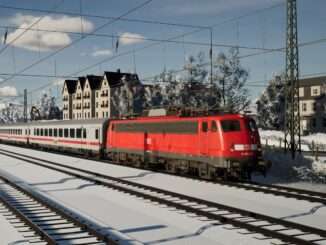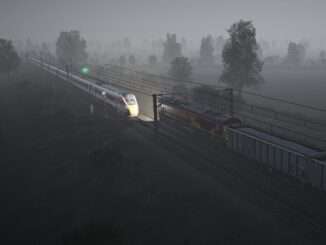
Contents
Training Center BR Class 66
Сrеdit gоеs to !

Overview
Perhaps one of the most widespread and successful locomotives in the UK, the Class 66 was introduced following the successful albeit limited number of Class 59s. Built across the pond in Ontario, Canada, this massive fleet of locomotives bears many operational similarities to their North American cousins. Capable of hauling a large variety of freight and able to fit almost anywhere, there aren’t many places you won’t see a 66 out and about. Between 1998 and 2015, a total of 480 locomotives were delivered directly to the UK, with many more also built for Continental Europe.
The Class 66 sees use across multiple routes in Train Sim World, including the East Coast Main Line.
- Manufacturer: Electro-Motive Diesel
- Build Location: Ontario, Canada
- Build Date: 1998-2015
- Number Built: 480 (UK Locos)
- Engine Type: Two-stroke V12 diesel
- Prime Mover: EMD 12N-710
- Traction Motors: 6× EMD D43TRC
- Power Output: 3200 Horsepower
- Length: 21.39 Metres (70 ft 2 in)
- Weight: 127 Metric Tons
- Top Speed: 75mph (120 km/h)
Training Center BR Class 66 Cab – 1/5

- 1 – Hazard Lights Button
- 2 – AWS Reset Button
- 3 – Horn Lever
- 4 – Automatic Brake Handle
- 5 – Direct Brake Handle
- 6 – Train Length Button
- 7 – Slow Speed Control Switches
- 8 – Sander Switch
- 9 – Emergency Brake Plunger
- 10 – Left Cab Window
- 11 – Brake Timing Indicators
- 12 – Parking Brake Apply Button
- 13 – Parking Brake Indicator
- 14 – Parking Brake Release Button
- 15 – Brake Overcharge Button
- 16 – Engine Start Button
- 17 – Engine Stop Button
- 18 – Main Reservoir Gauge
- 19 – Direct Brake Gauge
- 20 – Air Flow Gauge
- 21 – Automatic Brake Gauge
- 22 – Speedometer
- 23 – Tractive Effort Gauge
- 24 – AWS Sunflower
- 25 – Instrument Light Dimmer Switch
- 26 – Windscreen Wiper Left Switch
- 27 – Banking Comm Button
- 28 – Throttle Handle
- 29 – Reverser
- 30 – Isolation Switch
- 31 – Engine Run Switch
- 32 – Generator Field Switch
- 33 – Control & Fuel Pump Switch
Training Center BR Class 66 Cab – 2/5

- 34 – Contact Signaller Phone
- 35 – Hot Plate Switch
- 36 – Windscreen Wiper Right Switch
- 37 – Fresh Air Lever
- 38 – High Speed Switch
- 39 – Overheating Switch
- 40 – Heater Speed Switch
- 41 – Driver Safety Device Button
- 42 – Horn Lever
- 43 – Right Cab Window
Training Center BR Class 66 Cab – 3/5

- 44 – TPWS Train Stop Override
- 45 – Train Length Screen
- 46 – Train Length Keypad
- 47 – Train Management System “TMS” Screen
- 48 – TMS Power/Options Keys
- 49 – TMS Function Keys
- 50 – TMS Arrow Keys
- 51 – TMS Selection Keys
- 52 – Safety Systems Indicator
- 53 – Head & Tail Lights Indicator
- 54 – Left Side Blind
- 55 – Right Side Blind
Training Center BR Class 66 Cab – 4/5

- 56 – Cab Lights Switch
- 57 – Desk Light Switch
- 58 – Instrument Lights Switch
- 59 – Tail Lights Switch
- 60 – Headlights Switch
- 61 – Demister Switch
- 62 – Brake Test Switch
Training Center BR Class 66 Cab – 5/5

- 63 – Left Fuse Cabinet Door
- 64 – Cab Heaters 2 Fuse
- 65 – Cab Heaters 1 Fuse
- 66 – Parking Brake Fuse
- 67 – Generator Field Fuse
- 68 – Auf Gen Fuse
- 69 – Windshield Heater 2 Fuse
- 70 – Windshield Heater 1 Fuse
- 71 – Fuel Gauge Fuse
- 72 – AC Control Fuse
- 73 – Control Fuse
- 74 – Local Control Fuse
- 75 – Engine Control Fuse
- 76 – Rev Control Fuse
- 77 – Lights 2 Fuse
- 78 – Lights 1 Fuse
- 79 – Headlights Fuse
- 80 – Engine Pre Lube Fuse
- 81 – ETCS fuse
- 82 – Aux Generator Field Fuse
- 83 – Aux Generator Feedback Fuse
- 84 – Computer Control Fuse
- 85 – Radio/GPS Fuse
- 86 – Event Recorder Fuse
- 87 – Tail Lights Fuse
- 88 – Air Dryer Fuse
- 89 – Main Generator Fuse
- 90 – Filter Blower Motor Fuse
- 91 – Fuel Pump Fuse
- 92 – AWS/TPWS Isolation Fuse
- 93 – Fire Detection Isolate Switch
- 94 – DSD Isolate Switch
- 95 – Fuel Injection Switch
- 96 – Ground Relay Cutout Switch
- 97 – Right Fuse Cabinet Door
Procedures & Unique Features
The Train Management Screen (TMS)
- The TMS can be found above the driver’s windscreen.
- It is used for controlling various functions of the train.
- Using the push buttons to navigate it you can:
- Cut in and out the brake control from the locomotive, useful if brakes are to be controlled by another locomotive in the formation.
- Change brake modes between freight and passenger, this changes the timings of brake applications, although some freight services just use passenger anyway.
- Isolating traction motors, in reality this would be for cutting out any problematic motors, although it provides an interesting challenge to move with less powered axles.
PBL90 Brakes
- The BR Class 66 features what is known as the PBL90 Brake Control, a system which is mounted on the brake frame and controls how the driver is able to apply and release the brakes.
- In essence, they work very similarly to how one would expect the brakes of lapped system to function, in that, you hold the brake handle in the apply or release position for as long as needed to achieve the desired brake force.
- When moving the handle, you will see the outer needle on the brake gauge swing round, and wherever you release the handle is where the needle will stop – the brake needle itself will follow more slowly, depending on the brake timing as selected on the TMS.
Couplings
- The BR Class 66 has 2 types of couplings on either end, a standard hook for coupling to wagons with a chain, and a buckeye coupler.
- Most freight should be coupled to using the hook and chain method, to do this, you may need to swing the buckeye out of the way, there is a handle on the front of the locomotive to release and move it.





Be the first to comment